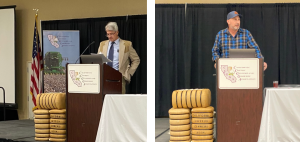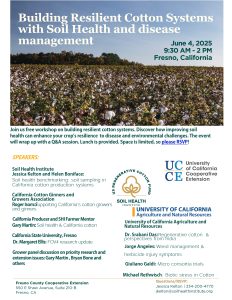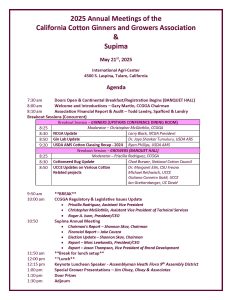The Jordan College of Agricultural Sciences and Technology is proud to announce the prestigious appointment of Dr. Margaret Ellis as the incoming J.G. Boswell Endowed Chair in Plant Science at Fresno State. Established through a generous $1.2 million gift from the James G. Boswell Foundation in 2004, the position has created a vessel for groundbreaking research and transformed student experiences in plant science. Dr. Ellis’ passion for agriculture began in her hometown in Illinois, where she participated in a local 4-H program. With a biology degree from the University of Illinois Urbana-Champaign, she began bridging her scientific background with her love of plants. She was introduced to the field of plant pathology when she started a position in a soybean pathology lab as an undergraduate student. Afterwards she completed her master’s and Ph.D. programs in Plant Pathology at Michigan State University and The Ohio State University, respectively. Upon joining Fresno State, Dr. Ellis embraced a new path, shifting her focus from Fusarium diseases in soybean to cotton. That pivot allowed her to continue working in Fusarium research—an area she continues to specialize in today. One of her earliest collaborators was the J.G. Boswell Company, which supported her initial survey work and played a key role in launching her research in California. “The disease I study is very important to growers in California,” Dr. Ellis explains. “Being named the J.G. Boswell Endowed Chair means a lot to me because it tells me the work I do matters. I love working one-on-one with students, and this position allows me to do even more of that.” Dr. Ellis’ impact resonates through her students, many of whom have gone on to pursue careers in research, university extension, and industry leadership. Several now work as technicians or farm managers within the University of California system and beyond. In her new role, Dr. Ellis will continue her work in cotton pathology, focusing on pathogen interactions – an area that desperately needs further exploration. For Dr. Ellis, the J.G. Boswell Endowed Chair in Plant Science empowers her to continue nurturing both of her passions: teaching and research. “I came to Fresno State because I wanted to teach. I love teaching and I love research. Getting this position is a happy marriage between both worlds.” Congratulations to Dr. Maggie Ellis, and a huge shoutout to the J.G. Boswell Company for their contribution to the future of the cotton industry in California.
NEWS & ISSUES
Zero-Emission Forklift Regulation – Authorization Update
On May 27, 2025, the California Air Resources Board (CARB) issued an advisory regarding the implementation of its Zero-Emission Forklift (ZEF) Regulation. The advisory clarifies that CARB has not yet sought authorization from the U.S. Environmental Protection Agency (EPA) under section 209(e)(2)(A) of the Clean Air Act. Consequently, CARB will not enforce the ZEF regulation against privately-owned or operated fleets, manufacturers, or dealerships until such authorization is granted or deemed unnecessary.
CARB is encouraging all manufacturers and fleets to voluntary report and the adopt zero-emission forklifts. This advisory provides temporary relief from enforcement. However, the Association remains concerned about the long-term implications of the ZEF regulation. The transition to zero-emission forklifts poses significant challenges as our state has not addressed the state wide infrastructure constraints with converting to all electric. We will continue to monitor this regulation and will keep you updated.
Association Part of Ag Industry Response to MAHA Commission Report
The Association as part of the Modern Ag Alliance expressed major concerns with the release of the Make America Healthy Again (MAHA) Commission report that questioned American farmers’ use of crop protection tools. “Farmers are already facing a host of challenges—uncertainty about their access to critical crop protection products shouldn’t be added to the list,” said Elizabeth Burns-Thompson, Executive Director of the Modern Ag Alliance. “Crop protection tools are not only safe, they are essential to food security, affordability, and the survival of family farms all across this country. Losing access to these critical inputs would be a devastating setback to American agriculture.” The Association’s President/CEO Roger Isom was quoted in the Modern Ag Alliance press release as saying “Crop protection tools that have been registered through EPA, have gone through the most rigorous, scientifically based, and health-protective process in the world. They have been analyzed to ensure there are no impacts to humans, workers, plants, animals, air quality, and groundwater. Application rates have been limited and buffer zones implemented to ensure the safest application possible, and where safety concerns could not be met, those chemicals are not registered for use in the United States. American agriculture already has far less tools than the rest of the world, and we cannot afford to lose any more and still produce the world’s best food and fiber.”
About The Modern Ag Alliance
The Modern Ag Alliance is a diverse coalition of more than 100 agricultural organizations advocating for U.S. farmers’ access to the crop protection tools they need to ensure we have a robust and affordable domestic food supply. To learn more, visit MODERNAGALLIANCE.ORG
CCGGA Wraps Up Another Successful Annual Meeting!
This past week, the California Cotton Ginners and Growers Association hosted its 2025 Annual Meeting in conjunction with Supima at the International Agri Center in Tulare, California. More than 120 participants attended the informative meeting with speakers covering a multitude of important issues. The morning began with the financial report from the Association’s auditing firm Spafford and Landry. Then the group broke into two sections: ginners and growers. The ginners were provided with updates from the National Cotton Ginners Association and its activities by current NCGA President Larry Black, the USDA ARS Southwest Cotton Ginning Laboratory and the research they are conducting by Dr. Jaya Shankar Tumuluru, and finally a presentation on the USDA classing of the 2024 cotton crop by Ryan Phillips of USDA AMS. Meanwhile the growers were briefed on the Cottonseed Bug by Chad Brewer of the National Cotton Council. Then the growers received a series of research updates by Dr. Margaret Ellis of CSU Fresno, Michael Rethwisch of UCCE, Giuliano Carneiro Galdi of UCCE and Ian Grettenberger of UC Davis. Then both groups came back together to receive an update from the Association staff led by Assistant Vice President Priscilla Rodriguez, Assistant Vice President of Technical Services Christopher McGlothlin, and President/CEO Roger Isom on some of the important issues the Association is tackling. Then, the meeting was turned over to Supima to have their Annual Meeting. Following lunch, special guest speaker, Assemblyman Heath Flora provided his perspective on Sacramento and how things are going at the State Capitol. 
SHI-UCCE California Cotton Workshop: Soil Health and Disease Management on June 4th, UCCE Fresno
The University of California Cooperative Extension is hosting a free workshop on building resilient cotton systems. More information can be found on the flyer below. The event will wrap up with a Q&A session. Lunch is provided. Space is limited, so please sign up at the link below.
Association Weighs in on Potential Listing of Monarch Butterfly
The US Fish and Wildlife Service is proposing to list the monarch butterfly (Danaus plexippus) as a threatened species under the Endangered Species Act (ESA). While recognizing the monarch’s ecological and cultural importance, the Association submitted comments respectfully opposing the proposed listing for several reasons.
First, the Environmental Protection Agency’s (EPA) Herbicide Strategy and Draft Insecticide Strategy are designed to minimize potential harm to the monarch and other non-target organisms by implementing mitigation measures that reduce spray drift, runoff, and collateral pesticide exposure. These strategies rely on refined risk assessments and population-level evaluations rather than individual-level restrictions, and they provide practical guidance—such as establishing buffer zones and adopting drift-reduction methods—that enable farmers to maintain effective weed and pest control.
Second, voluntary and targeted conservation programs are already succeeding. Multiple conservation programs, including the Conservation Reserve Program (CRP), the Environmental Quality Incentives Program (EQIP), and the Agricultural Conservation Easement Program (ACEP), have shown success in improving pollinator habitats across private and public lands, as documented in the Mid-America Monarch Conservation Strategy.
Third, if the monarch butterfly is listed as threatened, the agricultural sector may face additional regulatory burdens and uncertainties. For many commodities support hundreds of thousands of jobs and provide major economic value across multiple states, new restrictions could raise compliance costs and disrupt long-established practices.
In written comments submitted this past week, the Association commented that it believes USFW should focus on targeted habitat management instead of listing. Monarch butterfly declines are linked to factors such as habitat loss, changing land-use patterns, climate variation, and threats at overwintering sites, indicating that localized or targeted responses are more appropriate than a sweeping threatened listing. Encouraging strategic habitat enhancements, such as planting milkweed in priority locations, sustaining overwintering grounds, and funding pollinator-friendly crop rotation practices, will likely produce more direct benefits for the monarch. Given the effectiveness of existing pesticide strategies, proven voluntary programs, and targeted habitat improvements for monarch butterfly conservation, listing the species as threatened under the ESA is unnecessary at this time.
2025 CCGGA & Supima Annual Meeting – Tomorrow May 21
The California Cotton Ginners and Growers Association’s 2025 Annual Meeting in conjunction with Supima will be held on Wednesday, May 21st at the International Agri-Center in Tulare, CA. Registration and Continental Breakfast will begin at 7:30 am. The program will begin with Breakout Sessions at 8:30 am and will end with lunch.
A link to the Registration Form is below. Please complete and submit the form as soon as possible to allow the Association to make sure we can appropriately plan for the meeting. You can email the form to Michelle Franco at michelle@ccgga.org or fax it to our offices promptly at (559) 252-0551.
Unrealistic Proposed Changes to Cal/OSHA Heat Illness Rules
Cal/OSHA has proposed unrealistic changes to heat illness regulations—changes that can directly impact how you run your operations, if approved as proposed. Despite being framed as safety improvements, these new changes under Title 8 §3395 and §3396 go far beyond reasonable protections. They impose excessive paperwork, strict work restrictions, and unrealistic expectations on employers in the state. These proposed changes target acclimatization, employee monitoring, and written heat illness prevention plans.
The most concerning change is the mandatory acclimatization schedule triggered by any day over 80°F for new employees in outdoor workplaces and triggered when any indoor workplace is over 87°F. That could apply for half of the year in some areas in California, specifically the Central Valley. Under these new rules, new employees can only work at 20% capacity on Day 1, while returning employees are capped at 50%. Employers must restrict heat exposure for new and returning employees, regardless of their experience:
- New employees: Capped at 20% of normal workload on Day 1, increasing incrementally to 80% by Day 4.
- Returning employees (after 14 days): Capped at 50% on Day 1, reaching 80% by Day 3.
The schedules are lifted only if the employer can prove the worker has recently performed similar tasks under comparable heat conditions—a proof that requires more documentation.
On top of this, Cal/OSHA now requires employers to distribute their Heat Illness Prevention Plan, available in multiple languages, to new employees during:
- The time of hire
- During heat illness training
- And at least once annually (no more than twice per year)
Folks are already doing the right things—providing water, shade, training, and adjusting schedules when needed. These new rules don’t improve safety—they undermine the ability to operate a business in California.
We’re pushing back on these unrealistic proposed regulatory changes and will be submitting comments to the Cal OSHA Standards Board. The comment period for the proposed changes is open until July 7th, 2025. We’ll keep fighting on your behalf and pushing back on outlandish regulatory changes like this one.
Proposed Revisions to Wildfire Smoke Rule
The new proposed revisions to the Protection from Wildfire Smoke regulations under Cal/OSHA’s §5141.1, is impractical for farming operations. The proposed updated rule requires employers to provide NIOSH-approved respirators, such as N95s, to all agricultural employees when the AQI for PM2.5 reaches 151 but does not exceed 300, and mandates their use when the AQI exceeds 300. In addition, employers must now conduct medical evaluations for respirator use and track real-time air quality, when the AQI exceeds 500.
However, all other non-agricultural employees have a different threshold. All other employers with outdoor workers must provide N95’s when the AQI for PM2.5 reaches 151 but does not exceed 500 and mandates their use when the AQI exceeds 500. Why would agricultural employees be singled out versus all other industries with employees working outdoor? Where is the science-based approach to this? Existing safety practices and common-sense decisions have long protected workers during smoke events and this proposed regulation is yet another additional regulatory and biased burden. Adding to the burden are new demands for medical evaluations (when the AQI exceeds 500), respirator supply logistics, and AQI monitoring.
There needs to be a more flexible, risk-based approach that supports both worker health and economic sustainability. Voluntary protections and practical risk assessments would better serve both worker safety and agricultural sustainability. The Association is strongly opposed to the proposed changes and will be submitting comments during the open comment period which closes July 7th, 2025. Stay tuned for updates.
CARB Rolls Back Clean Fleets/Trucks Regulations
Earlier this month, the California Air Resources Board (CARB) announced the intention to roll back the requirement to electrify California fleets. Passed in 2024, The Advanced Clean Fleets (ACF) and the Advanced Clean Trucks (ACT) rules were controversial from the start. The ACT rule required equipment manufacturers to meet in-state sales benchmarks of zero-emission vehicles, culminating in 100% sales of ZEVs in the state by 2036. The ACF rule would require applicable businesses to replace existing fossil fuel burning vehicles with ZEVs at certain annual benchmarks. The passage of the rules was met with immediate legal challenges, and ultimately needed waiver approval from the U.S. Environmental Protection Agency in order to enforce the regulation.
CARB has announced that, as part of their legal settlement with 17 states as well as the California Trucking Association, that the agency will not be enforcing the mandatory ZEV sales requirement on manufacturer’s inventory. Additionally, changes to the ACT rule remove priority fleets and drayage trucks from being the first equipment category to electrify. While this is welcomed news for overregulated California industries, CARB intends to wait out the current federal administration with the hopes of reintroducing the waiver petition to EPA during a more favorable presidential cabinet.

